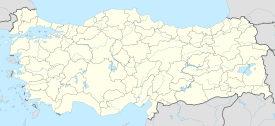Sestus
| Σηστός | |

Sestos and the Hellespont
|
|
| Location | Bigalı, Çanakkale Province, Turkey |
|---|---|
| Region | Thracian Chersonese |
| Coordinates | 40°13′N 26°23′E / 40.217°N 26.383°ECoordinates: 40°13′N 26°23′E / 40.217°N 26.383°E |
| Type | Settlement |
Sestos (Greek: Σηστός) or Sestus was an ancient Greek town of the Thracian Chersonese, the modern Gallipoli peninsula in European Turkey. Situated on the Hellespont opposite Abydos, it was the home of Hero in the legend of Hero and Leander, where according to legend she lived in a tower overlooking the sea. Sestos was an Aeolian colony, as it was founded by settlers from Lesbos. The ruins of the town are near to the modern settlement of Eceabat.
During the Persian rule, Sestos alongside Byzantium were the two Achaemenid ports of utmost importance on the European coasts of the Bosphorus and the Hellespont. In 480 BC, Xerxes' army crossed at this point on two temporary pontoon bridges later known as Xerxes' Pontoon Bridges, and most of Alexander the Great's forces went the other way here by boat in 334 BC.
In 1810 Lord Byron swam from Sestos to Abydos in one hour 10 minutes, recreating Leander's feat, and wrote a poem thereafter. This event is commemorated every year with an annual swim event that recreates the crossing.
Little now remains of the ancient town of Sestos.
Sestos is central to Christopher Marlowe's poem Hero and Leander, and is referred to in its opening lines:
On Hellespont, guilty of true love's blood,
In view and opposite two cities stood,
Sea-borderers, disjoin'd by Neptune's might:
The one Abydos, the other Sestos .
At Sestos Hero dwelt; Hero the fair,
Whom young Apollo courted for her hair.
...
Wikipedia

